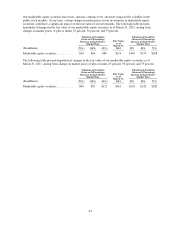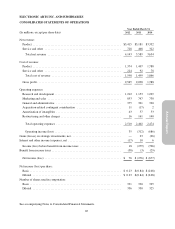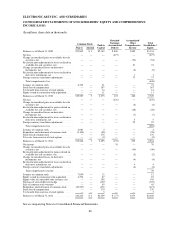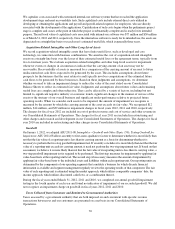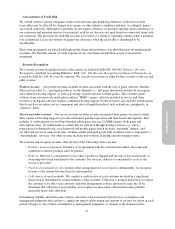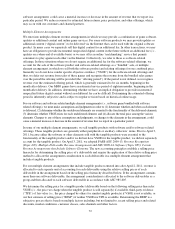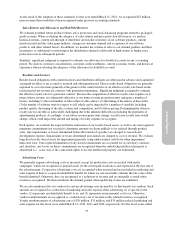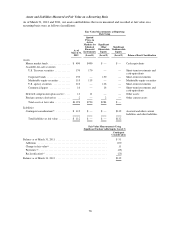Electronic Arts 2012 Annual Report Download - page 156
Download and view the complete annual report
Please find page 156 of the 2012 Electronic Arts annual report below. You can navigate through the pages in the report by either clicking on the pages listed below, or by using the keyword search tool below to find specific information within the annual report.software arrangement, could cause a material increase or decrease in the amount of revenue that we report in a
particular period. We reduce revenue for estimated future returns, price protection, and other offerings, which
may occur with our customers and channel partners.
Multiple-Element Arrangements
We enter into multiple-element revenue arrangements in which we may provide a combination of game software,
updates or additional content and online game services. For some software products we may provide updates or
additional content (“digital content”) to be delivered via the Internet that can be used with the original software
product. In many cases we separately sell this digital content for an additional fee. In other transactions, we may
have an obligation to provide incremental unspecified digital content in the future without an additional fee (i.e.,
updates on a when-and-if-available basis) or we may offer an online “matchmaking” service that permits
consumers to play against each other via the Internet. Collectively, we refer to these as software-related
offerings. In those situations where we do not require an additional fee for the software-related offerings, we
account for the sale of the software product and software-related offerings as a “bundled” sale, or multiple
element arrangement, in which we sell both the software product and relating offerings for one combined price.
Generally we do not have vendor specific objective evidence (“VSOE”) for the software-related offerings and
thus, we defer net revenue from sales of these games and recognize the revenue from the bundled sales games
over the period the offering will be provided (the “offering period”). If the period is not defined, we recognize
revenue over the estimated offering period, which is generally estimated to be six months, beginning in the
month after delivery. Our MMO games have an estimated service period of eighteen months, beginning in the
month after delivery. In addition, determining whether we have an implicit obligation to provide incremental
unspecified future digital content without an additional fee can be difficult. Determining the estimated offering
period is inherently subjective and is subject to regular revision based on historical online usage.
For our software and software-related multiple element arrangements (i.e., software game bundled with software
related offerings), we must make assumptions and judgments in order to (1) determine whether and when each element
is delivered, (2) determine whether the undelivered elements are essential to the functionality of the delivered elements,
(3) determine whether VSOE exists for each undelivered element, and (4) allocate the total price among the various
elements. Changes to any of these assumptions and judgments, or changes to the elements in the arrangement, could
cause a material increase or decrease in the amount of revenue that we report in a particular period.
In some of our multiple element arrangements, we sell tangible products with software and/or software-related
offerings. These tangible products are generally either peripherals or ancillary collectors’ items. Prior to April 3,
2011, because either the software or other elements sold with the tangible products were essential to the
functionality of the tangible product and/or we did not have VSOE for the tangible product, we did not separately
account for the tangible product. On April 3, 2011, we adopted FASB ASU 2009-13, Revenue Recognition
(Topic 605): Multiple-Deliverable Revenue Arrangements and ASU 2009-14, Software (Topic 985): Certain
Revenue Arrangements that Include Software Elements. The new accounting principles establish a selling price
hierarchy for determining the selling price of a deliverable and require the application of the relative selling price
method to allocate the arrangement consideration to each deliverable in a multiple element arrangement that
includes tangible products.
For our multiple element arrangements that include tangible products entered into after April 2, 2011, revenue is
allocated to each separate unit of accounting for each deliverable using the relative selling prices of each
deliverable in the arrangement based on the selling price hierarchy described below. If the arrangement contains
more than one software deliverable, the arrangement consideration is allocated to the software deliverables as a
group and then allocated to each software deliverable in accordance with ASC 985-605.
We determine the selling price for a tangible product deliverable based on the following selling price hierarchy:
VSOE (i.e., the price we charge when the tangible product is sold separately) if available, third-party evidence
(“TPE”) of fair value (i.e., the price charged by others for similar tangible products) if VSOE is not available, or
our best estimate of selling price (“BESP”) if neither VSOE nor TPE is available. Determining the BESP is a
subjective process that is based on multiple factors including, but not limited to, recent selling prices and related
discounts, market conditions, customer classes, sales channels and other factors.
72


